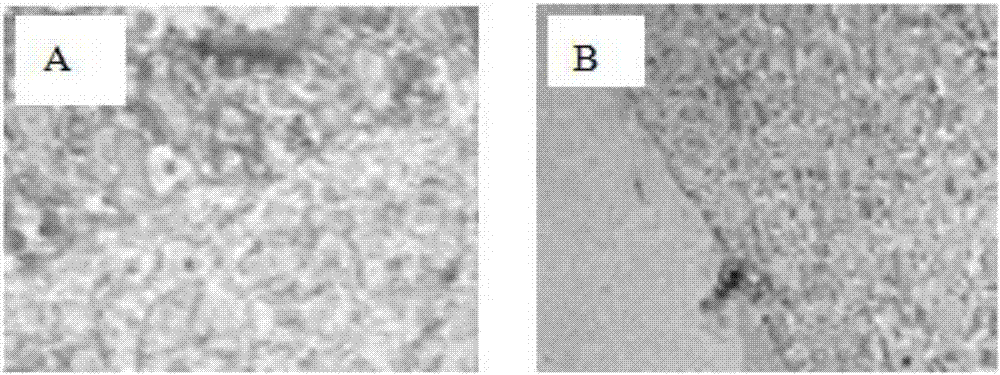Preparation method of accellular amniotic membrane for skin biological stents of tissue engineering
A tissue-engineered skin and bio-scaffold technology, which is applied in the field of preparation of decellularized amniotic membrane, can solve the problems of inconvenient storage, inability to take it at any time, introduction of allogeneic cells into immunogenicity, etc., and achieve the effect of avoiding mechanical damage
- Summary
- Abstract
- Description
- Claims
- Application Information
AI Technical Summary
Problems solved by technology
Method used
Image
Examples
Embodiment 1
[0026] Example 1: Preparation of acellular amniotic membrane
[0027] The placenta is taken and serum tested to exclude HIV, syphilis, HBV and HCV infection. Under aseptic conditions, the amniotic membrane was peeled off from the inner layer of the placenta, placed in sterile saline, washed repeatedly to remove blood stains on the surface of the amniotic membrane, and bluntly removed the chorion of the amniotic membrane with tweezers.
[0028] After repeatedly rinsing the amniotic membrane with PBS with PH=6.5-7.0, soak it in 100U penicillin for 5 minutes and soak it in PBS for 10 minutes. Repeat this soaking process 3 times; after re-rinsing with PBS, put the amniotic membrane into DMEM: glycerol=1 :1 in solution, stored at -80℃ for 6 months;
[0029] Detect the amniotic membrane without virus infection, freeze and thaw 3 times from -80℃ to 37℃. After this process is completed, incubate the amniotic membrane in 0.25% trypsin-EDTA overnight for about 12h at 4℃;
[0030] The digestion...
Embodiment 2
[0031] Example 2: Preparation of acellular amniotic membrane
[0032] The placenta is taken and serum tested to exclude HIV, syphilis, HBV and HCV infection. Under aseptic conditions, the amniotic membrane was peeled off from the inner layer of the placenta, placed in sterile saline, washed repeatedly to remove blood stains on the surface of the amniotic membrane, and bluntly removed the chorion of the amniotic membrane with tweezers.
[0033] After repeatedly rinsing the amniotic membrane with PBS with PH=6.5-7.0, soak it in 200U streptomycin for 5 minutes and soak it in PBS for 10 minutes. The soaking process is repeated 3 times; after re-rinsing with PBS, put the amniotic membrane into DMEM: glycerol =1: In a solution of 2.5, stored at -80℃ for 6 months;
[0034] Detect the amniotic membrane without virus infection, freeze and thaw it twice from -80℃ to 37℃. After this process is completed, incubate the amniotic membrane overnight in 0.5% trypsin-EDTA for about 12h at 4℃;
[0035]...
Embodiment 3
[0036] Example 3: Preparation of acellular amniotic membrane
[0037] The placenta is taken and serum tested to exclude HIV, syphilis, HBV and HCV infection. Under aseptic conditions, the amniotic membrane was peeled off from the inner layer of the placenta, placed in sterile saline, washed repeatedly to remove blood stains on the surface of the amniotic membrane, and bluntly removed the chorion of the amniotic membrane with tweezers.
[0038] After repeatedly rinsing the amniotic membrane with PBS with PH=6.5-7.0, soak it in 150U azithromycin for 5 minutes and soak it in PBS for 10 minutes. This soaking process is repeated 3 times; after re-rinsing with PBS, put the amniotic membrane into DMEM: glycerol=1 :Store in solution of 5 for 6 months at -80℃;
[0039] Detect the amniotic membrane without virus infection, freeze and thaw 4 times from -80℃ to 37℃. After this process is completed, the amniotic membrane is incubated overnight in 0.1% trypsin-EDTA for about 12h at 4℃;
[0040] Th...
PUM
 Login to View More
Login to View More Abstract
Description
Claims
Application Information
 Login to View More
Login to View More - R&D
- Intellectual Property
- Life Sciences
- Materials
- Tech Scout
- Unparalleled Data Quality
- Higher Quality Content
- 60% Fewer Hallucinations
Browse by: Latest US Patents, China's latest patents, Technical Efficacy Thesaurus, Application Domain, Technology Topic, Popular Technical Reports.
© 2025 PatSnap. All rights reserved.Legal|Privacy policy|Modern Slavery Act Transparency Statement|Sitemap|About US| Contact US: help@patsnap.com


